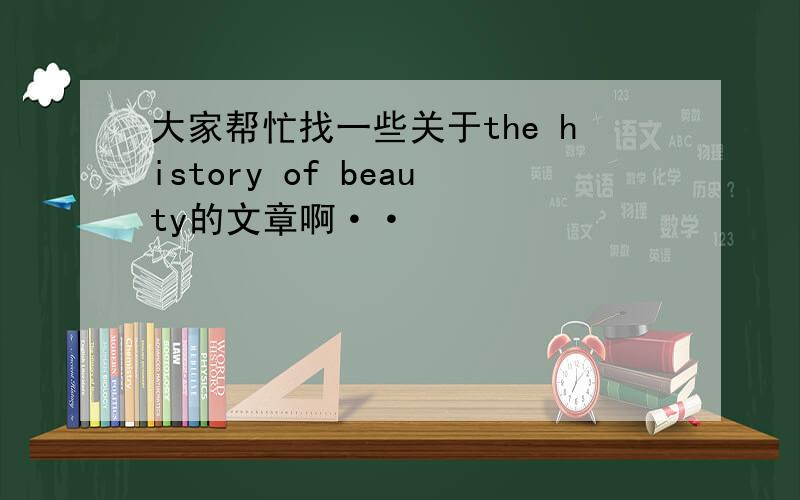大家帮忙找一些关于the history of beauty的文章啊··
来源:学生作业帮 编辑:神马作文网作业帮 分类:英语作业 时间:2024/11/10 16:42:43
大家帮忙找一些关于the history of beauty的文章啊··
意思就是“美”的历史,这里的美是名词··比如对美的鉴赏的历史啊什么什么的··中外皆可
要英语的···
好的话一定会有很多追加分的!
意思就是“美”的历史,这里的美是名词··比如对美的鉴赏的历史啊什么什么的··中外皆可
要英语的···
好的话一定会有很多追加分的!

What Is Beautiful?A Brief Look Through History
In ancient China,the 4-inch "lotus foot" was considered a sign of perfect beauty.The practice of foot-binding,uncommonly seen today,involved breaking the bones of the forefoot and folding them forward,then tying the misshapen appendage to prohibit growth.[5] Foot-binding caused severe pain,imbalance,and falls,and eventually osteoporosis,because afflicted women were unable to bear weight and ambulate correctly.Other consequences included hip and knee osteoarthritis,chronic pain,and even joint replacement surgery.[6] Chinese foot binding was also a form of subjugation; as a class,women were even less able to take advantage of already limited educational and economic opportunities.
For ancient Egyptians,Romans,and Persians,sparkling eyes were considered beautiful and they applied the heavy metal antimony to make their conjunctiva sparkle.[5] A woman with a high forehead was considered beautiful during the Elizabethan era,and upper-class Elizabethan women plucked or shaved their frontal hairs to achieve this look.These women also covered their skin with ceruse (lead-based) makeup,which caused peripheral neuropathy,gout,anemia,chronic renal failure,and disfiguring scarring,requiring the application of more ceruse makeup.[5] Chronic users,such as Queen Elizabeth I,acquired a misshapen appearance.Upset over her grisly visage,the Queen banished all mirrors from her castle.Her servants sometimes painted a red dot on her nose,an inside joke mocking her clown-like appearance.[5]
In the court of Louis XVI,noblewomen drew blue veins onto their necks and shoulders to emphasize their exalted status ("bluebloods").[7] In the 16th and 17th centuries,the wealthy used belladonna eyedrops to dilate their pupils.[5] Users acquired an "attractive" doe-like appearance,but they also risked retinal damage,glaucoma,and blindness.During the 18th century,vermilion rouge,concocted of sulphur and mercury,achieved popularity.Users lost teeth,suffered gingivitis,and (unknowingly) risked kidney and nervous system damage from mercury -- not to mention their having to deal with the unpleasant smell of sulphur.[7]
Corseting,popular from the 14th to 19th centuries,originally involved compressing the bosom and constricting the waist with tightly wound whalebone on a steel frame.[5] Shallow breathing,combined with inadequate venous return,produced fainting and swooning.Hiatal hernias caused by overly tight corsets are termed "Sommerring's syndrome" -- after the 18th century physician who first warned of the dangers of tight lacing.[8] Christina Larson points out,"the corset facilitated a pernicious association between physical beauty and virtue,as upright posture and a slender waist came to be regarded as evidence of discipline,modesty,rigor,and refinement.Ladies who abandoned their stays were scorned as both lazy and immoral."[9]
Ideal body weight and shape have fluctuated throughout history,from the rotund Venus of Willendorf of antiquity,to the statuesque,leggy flappers of the 1920s,to the ultra-thin "Twiggy"-inspired look of the 1960s and the "heroin chic" cachexia of the 1990s.In some cultures (eg,Hawaiian royalty),women voluntarily consumed or were force-fed excessive quantities of food to maintain their corpulence,a sign of fertility and power.[5] At other times,women,including those with and without anorexia and bulimia,have dieted,induced vomiting,abused laxatives,and exercised excessively to lose weight.Famed opera singer Maria Callas deliberately infected herself with tapeworms to produce a malabsorption syndrome to maintain her lithe figure.[5]
In ancient China,the 4-inch "lotus foot" was considered a sign of perfect beauty.The practice of foot-binding,uncommonly seen today,involved breaking the bones of the forefoot and folding them forward,then tying the misshapen appendage to prohibit growth.[5] Foot-binding caused severe pain,imbalance,and falls,and eventually osteoporosis,because afflicted women were unable to bear weight and ambulate correctly.Other consequences included hip and knee osteoarthritis,chronic pain,and even joint replacement surgery.[6] Chinese foot binding was also a form of subjugation; as a class,women were even less able to take advantage of already limited educational and economic opportunities.
For ancient Egyptians,Romans,and Persians,sparkling eyes were considered beautiful and they applied the heavy metal antimony to make their conjunctiva sparkle.[5] A woman with a high forehead was considered beautiful during the Elizabethan era,and upper-class Elizabethan women plucked or shaved their frontal hairs to achieve this look.These women also covered their skin with ceruse (lead-based) makeup,which caused peripheral neuropathy,gout,anemia,chronic renal failure,and disfiguring scarring,requiring the application of more ceruse makeup.[5] Chronic users,such as Queen Elizabeth I,acquired a misshapen appearance.Upset over her grisly visage,the Queen banished all mirrors from her castle.Her servants sometimes painted a red dot on her nose,an inside joke mocking her clown-like appearance.[5]
In the court of Louis XVI,noblewomen drew blue veins onto their necks and shoulders to emphasize their exalted status ("bluebloods").[7] In the 16th and 17th centuries,the wealthy used belladonna eyedrops to dilate their pupils.[5] Users acquired an "attractive" doe-like appearance,but they also risked retinal damage,glaucoma,and blindness.During the 18th century,vermilion rouge,concocted of sulphur and mercury,achieved popularity.Users lost teeth,suffered gingivitis,and (unknowingly) risked kidney and nervous system damage from mercury -- not to mention their having to deal with the unpleasant smell of sulphur.[7]
Corseting,popular from the 14th to 19th centuries,originally involved compressing the bosom and constricting the waist with tightly wound whalebone on a steel frame.[5] Shallow breathing,combined with inadequate venous return,produced fainting and swooning.Hiatal hernias caused by overly tight corsets are termed "Sommerring's syndrome" -- after the 18th century physician who first warned of the dangers of tight lacing.[8] Christina Larson points out,"the corset facilitated a pernicious association between physical beauty and virtue,as upright posture and a slender waist came to be regarded as evidence of discipline,modesty,rigor,and refinement.Ladies who abandoned their stays were scorned as both lazy and immoral."[9]
Ideal body weight and shape have fluctuated throughout history,from the rotund Venus of Willendorf of antiquity,to the statuesque,leggy flappers of the 1920s,to the ultra-thin "Twiggy"-inspired look of the 1960s and the "heroin chic" cachexia of the 1990s.In some cultures (eg,Hawaiian royalty),women voluntarily consumed or were force-fed excessive quantities of food to maintain their corpulence,a sign of fertility and power.[5] At other times,women,including those with and without anorexia and bulimia,have dieted,induced vomiting,abused laxatives,and exercised excessively to lose weight.Famed opera singer Maria Callas deliberately infected herself with tapeworms to produce a malabsorption syndrome to maintain her lithe figure.[5]
大家帮忙找一些关于the history of beauty的文章啊··
请大家帮忙找一些关于生物多样性的文章或信息,越多越好,
HISTORY OF BEAUTY怎么样
英语翻译大家帮忙翻译下这篇文章-------------------------------The History Of
帮忙找beauty and the beast的歌词!最好中英对照
帮忙找一篇关于the power of love的文章还有阅读题
帮忙找一篇关于 symbol of china 的文章
请大家帮忙找一些回报母爱、父爱的文章片段(300字左右)
请大家帮忙找一些关于读书名言
大家帮忙找一些关于物理比热容的题,比较需要动脑筋的,
麻烦大家帮忙找一些关于物理惯性现象的诗句
请大家帮忙找一下关于孝心事迹的文章或材料.